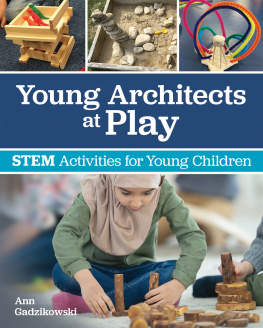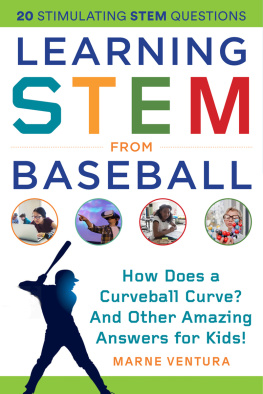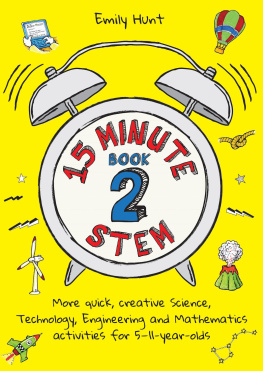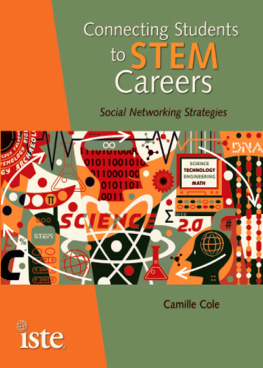Whats Your STEM?
Activities to Discover Your Child's Potential in Science, Technology, Engineering, and Math
Rihab Sawah, MS, MA, and Anthony Clark, PhD

Avon, Massachusetts
Adams Media
An imprint of Simon & Schuster
57 Littlefield Street, Avon, MA 02322
www.adamsmedia.com
Copyright 2017 by Simon and Schuster
All rights reserved, including the right to reproduce this book or portions thereof in any form whatsoever. For information address Adams Media Subsidiary Rights Department, 1230 Avenue of the Americas, New York, NY 10020.
ADAMS MEDIA and colophon are trademarks of Simon and Schuster.
Cover design by Stephanie Hannus.
Cover image nongpimmy/Getty Images.
Interior illustrations by Dave Forbes.
For information about special discounts for bulk purchases, please contact Simon & Schuster Special Sales at 1-866-506-1949 or .
The Simon & Schuster Speakers Bureau can bring authors to your live event. For more information or to book an event contact the Simon & Schuster Speakers Bureau at 1-866-248-3049 or visit our website at www.simonspeakers.com .
ISBN 10: 1-5072-0064-1
ISBN 13: 978-1-5072-0064-3
eISBN 10: 1-5072-0065-X
eISBN 13: 978-1-5072-0065-0
Many of the designations used by manufacturers and sellers to distinguish their products are claimed as trademarks. Where those designations appear in this book and Simon & Schuster, Inc., was aware of a trademark claim, the designations have been printed with initial capital letters.
To Dave Frey, David Stewart, and Elmer Smiththree Crystal City boys whove taught us a lot about STEM and even more about life.
Introduction
Short for science, technology, engineering, and mathematics, STEM represents much more than a collection of school subjects or classes. Its an exciting world that goes well beyond the walls of a classroom and into the world around us. STEM answers countless questions kids (and adults!) ask every day: How exactly does a bridge stay up? What do meteorologists mean by high pressure and low pressure? Why are there so few people with red hair? Whats the probability that someone else has the same birthday as you?
Figuring out the answers to these questions doesnt have to be boring, intimidating, or done by a trained scientist. You can unearth them with your whole family, in your own home, with materials you have on hand.
Kids are naturally curious about the world around themnurture that curiosity with fun, engaging activities that teach as they entertain. Your daughter might discover that she has a real knack for statisticsmaybe shed like her schools math club. Your son might realize he loves all things plants, and start volunteering at the community garden. These interests could even spawn a successful career well down the road.
According to the Bureau of Labor Statistics of the U.S. Department of Labor, unemployment rates are lower and average wages are higher in STEM fields than in non-STEM fields. Job market analytics company Burning Glass Technologies found that entry-level jobs in STEM pay roughly 28 percent more on average than entry-level jobs in other fields. Despite these healthy job prospects in STEM, many young people choose other paths. Some likely steer clear of STEM because the subjects are difficult. One way you can help your kids face challenging coursework is by providing opportunities for learning outside the classroomsuch as the activities in this book.
Even if your child doesnt choose a career in STEM later in life, the activities in this book will help him or her develop the kind of critical thinking skills necessary in a wide variety of classes, internships, and jobs: A nonprofit fundraiser needs to master how to calculate compound interest; a chef should know how certain ingredients interact on a chemical level; and its essential for a soccer coach to understand Newtons three laws of motion.
Whats Your STEM? offers more than fifty learning activities designed to introduce young learners to a wide variety of STEM fields. Youll want to do many of the activities with your child, to guide and oversee the process. Depending on the age and aptitude of your child, she may enjoy exploring some of the activities on her own. In addition to the hands-on activities, Whats Your STEM? describes a variety of STEM careers your child might like to hear aboutfrom aerospace engineer to web developer.
Use these activities to take STEM beyond the classroom, out from under its educational acronym, and into your home. Build your childs confidence, fuel passions, and spark interests. Make STEM concepts familiar, achievable, excitingand above all, fun.
Chapter 1
STEM Basics
If you dont work in a STEM field, you might need a refresher on some fundamental concepts before you start working with your child on the activities in the book. This chapter offers a basic introduction to the various fields in the industry, and includes a hands-on learning activity designed to help you explore the scientific method.
What Is Science?
When you hear the word science, a number of images probably come immediately into your mind. You might think of a laboratory featuring beakers and Bunsen burners, or a scientist in a white lab coat looking through a microscope, or a tweed-coated professor peering at the stars through a telescope. Perhaps the word conjures up images of the periodic table, or high-school biology students dissecting a frog. Science certainly includes images like those, but its a broader concept than many people realize.
Science is a process for discovering knowledge or uncovering general truths based on observation and experimentation. Science also refers to the body of knowledge that results from that process. You can think of science as a process of discovery, along with all the discoveries that are made along the way and the application of those discoveries.
STEM Words to Know
serendipity
Not all scientific discoveries arrive through experimentationsome have come more or less by accident. A happy accident like that is called serendipity, and there are many examples of it occurring in science throughout the years. Alexander Fleming, a Scottish scientist, left a petri dish open by mistake and it became contaminated by a bacteria-killing mold. That accident marked the discovery of penicillin. While testing radar equipment for the Raytheon company, a worker noticed that a candy bar had melted in his pocket, leading to the development of the microwave oven. Safety glass came about when a lab worker forgot to wash out a glass beaker and the plastic that it had contained coated the inside of the beaker.
One of the most basic distinctions is to divide scientific work into basic science and applied science. Basic science involves the discovery of new knowledge or fundamental principles. Applied science involves utilizing already existing knowledge for some purpose. The discovery of x-rays would be considered basic science. The use of x-rays to examine fractured bones is applied science. All fields of science have basic aspects and applied aspects.
Fields of Science
Science is divided into a number of scientific disciplines or fields. The major scientific fields are then further divided into subfields. Here are some of the most common STEM fields.
STEM Career Choices
Science Teacher









